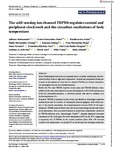The cold-sensing ion channel TRPM8 regulates central and peripheral clockwork and the circadian oscillations of body temperature

View/
Use this link to cite
http://hdl.handle.net/2183/32355
Except where otherwise noted, this item's license is described as Creative Commons Attribution-NonCommercial 4.0 International License (CC-BY-NC 4.0)
Collections
- Investigación (FCS) [1293]
Metadata
Show full item recordTitle
The cold-sensing ion channel TRPM8 regulates central and peripheral clockwork and the circadian oscillations of body temperatureAuthor(s)
Date
2022-10-17Citation
Reimúndez A, Fernández-Peña C, Ordás P, Hernández-Ortego P, Gallego R, Morenilla-Palao C, Navarro J, Martín-Cora F, Pardo-Vázquez JL, Schwarz LA, Arce V, Viana F, Señarís R. The cold-sensing ion channel TRPM8 regulates central and peripheral clockwork and the circadian oscillations of body temperature. Acta Physiol (Oxf). 2023 Mar;237(3):e13896.
Abstract
[Abstract] Aim: Physiological functions in mammals show circadian oscillations, synchronized by daily cycles of light and temperature. Central and peripheral clocks participate in this regulation. Since the ion channel TRPM8 is a critical cold sensor, we investigated its role in circadian function.
Methods: We used TRPM8 reporter mouse lines and TRPM8-deficient mice. mRNA levels were determined by in situ hybridization or RT-qPCR and protein levels by immunofluorescence. A telemetry system was used to measure core body temperature (Tc).
Results: TRPM8 is expressed in the retina, specifically in cholinergic amacrine interneurons and in a subset of melanopsin-positive ganglion cells which project to the central pacemaker, the suprachiasmatic nucleus (SCN) of the hypothalamus. TRPM8-positive fibres were also found innervating choroid and ciliary body vasculature, with a putative function in intraocular temperature, as shown in TRPM8-deficient mice. Interestingly, Trpm8-/- animals displayed increased expression of the clock gene Per2 and vasopressin (AVP) in the SCN, suggesting a regulatory role of TRPM8 on the central oscillator. Since SCN AVP neurons control body temperature, we studied Tc in driven and free-running conditions. TRPM8-deficiency increased the amplitude of Tc oscillations and, under dim constant light, induced a greater phase delay and instability of Tc rhythmicity. Finally, TRPM8-positive fibres innervate peripheral organs, like liver and white adipose tissue. Notably, Trpm8-/- mice displayed a dysregulated expression of Per2 mRNA in these metabolic tissues.
Conclusion: Our findings support a function of TRPM8 as a temperature sensor involved in the regulation of central and peripheral clocks and the circadian control of Tc.
Keywords
TRPM8
Body temperature
Central and peripheral clocks
Circadian regulation
Sensory physiology
Body temperature
Central and peripheral clocks
Circadian regulation
Sensory physiology
Editor version
Rights
Creative Commons Attribution-NonCommercial 4.0 International License (CC-BY-NC 4.0)
ISSN
1748-1708






